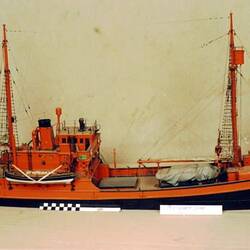Summary
Australia
Centenary medal, cast in 2001
Awarded to: Dr Phillip Law
Medal set comprising medal, miniature and lapel or tie pin. The Commonwealth Star represents the States and Territories. the indigenous design represents Aboriginal traditions at the heart of the continent. The hundred dots represent 100 years. The colours of the ribbons represent crimson for Federation and blue and yellow for the beginning of the 21st Century. The seven lines symbolise the pathway with which the states became one.
Physical Description
Set containing medal with ribbon, miniature, and lapel pin, in black presentation box. Hanging loop at top; blue ribbon with red and yellow vertical stripes. Miniature is identical, except lacking the reverse inscription. Tie or lapel pin is circular, with spiral pattern.
Obverse Description
Medal & miniature: 7-pointed, raised Commonwealth star, indigenous design in centre. Around centre, Centenary of Federation 1901 - 2001. Around rim, 100 dots.
Reverse Description
Medal only: Outline of the Commonwealth star with the inscription FOR CONTRIBUTION MADE TO AUSTRALIAN SOCIETY. In centre, PHILLIP GARTH LAW. Around rim, 100 dots.
Significance
This group of plaques and medals contribute to both a significant collection relating to Antarctic explorer and director Phillip Law and to a growing collection of medals designed by significant Australian medallist Michael Meszaros.
The donor, Dr Phillip Garth Law, A.C., C.B.E., F.T.S.E., F.A.A, was the first Director of the Antarctic Division of the Commonwealth Department of External Affairs, now the Australian Antarctic Division of the Commonwealth Department of Environment and Heritage. Under Dr Law's Directorship Australia established a permanent presence in Antarctica. Joining the Australian National Antarctic Research Expedition (ANARE) in 1947, Dr Law was appointed Director of the newly-formed Division in 1949, a post he held until his retirement in 1966. He was instrumental in the development of the Antarctic Division and the ANARE programs and led the expeditions that established Australia's three Antarctic stations: Mawson in 1954; Davis in 1957; and Casey in 1964. These expeditions and others led by Dr Law between 1954 and 1966 explored and mapped 5000 kilometres of the coastline of the Australian Antarctic Territory while the wintering parties at ANARE stations under his direction explored nearly 2 million square kilometres of previously unknown territory. During this time an extensive variety of scientific programs was developed including Australia's contributions to the International Geophysical Year. Phillip Law has received wide recognition for his work including Australia's highest award (the A.C.), the British C.B.E. and Polar Medal, the Founder's Gold Medal of the Royal Geographical Society, honorary doctorates from three Australian universities and a number of other awards. He is a fellow of the Australian Academy of Science and the Australian Academy of Technological Sciences and Engineering.
More Information
-
Collection Names
-
Collecting Areas
-
Acquisition Information
Donation from Dr Phillip G. Law AC CBE - Australian Antarctic Division, 11 Dec 2003
-
Date Issued
2001 AD
-
Issued By
-
Awarded To
Dr Phillip G. Law AC CBE - Australian Antarctic Division, 16 Stanley Grove, Canterbury, Greater Melbourne, Victoria, Australia, 2001
-
Classification
-
Category
-
Discipline
-
Type of item
-
Shape
Rectangle
-
Keywords
